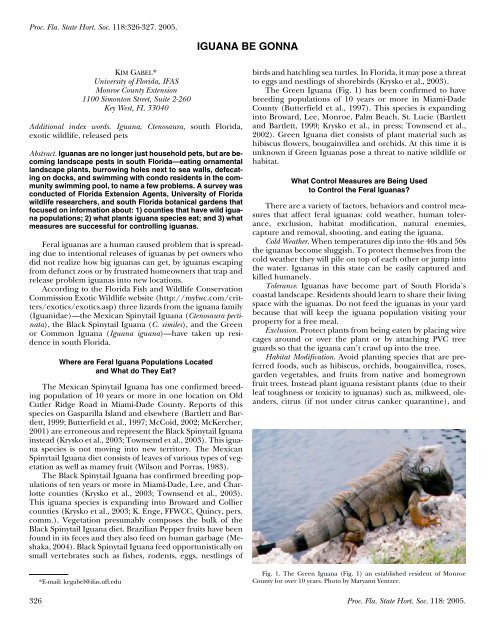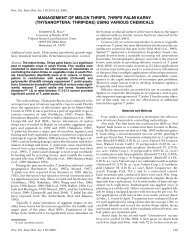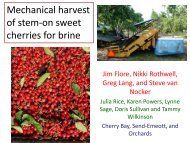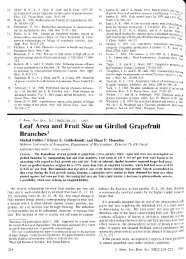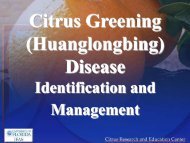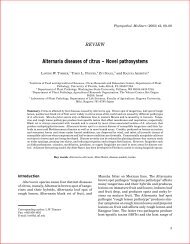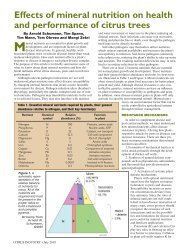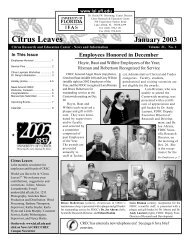IGUANA BE GONNA - University of Florida
IGUANA BE GONNA - University of Florida
IGUANA BE GONNA - University of Florida
You also want an ePaper? Increase the reach of your titles
YUMPU automatically turns print PDFs into web optimized ePapers that Google loves.
Proc. Fla. State Hort. Soc. 118:326-327. 2005.<br />
<strong>IGUANA</strong> <strong>BE</strong> <strong>GONNA</strong><br />
KIM GA<strong>BE</strong>L*<br />
<strong>University</strong> <strong>of</strong> <strong>Florida</strong>, IFAS<br />
Monroe County Extension<br />
1100 Simonton Street, Suite 2-260<br />
Key West, FL 33040<br />
Additional index words. Iguana, Ctenosaura, south <strong>Florida</strong>,<br />
exotic wildlife, released pets<br />
Abstract. Iguanas are no longer just household pets, but are becoming<br />
landscape pests in south <strong>Florida</strong>—eating ornamental<br />
landscape plants, burrowing holes next to sea walls, defecating<br />
on docks, and swimming with condo residents in the community<br />
swimming pool, to name a few problems. A survey was<br />
conducted <strong>of</strong> <strong>Florida</strong> Extension Agents, <strong>University</strong> <strong>of</strong> <strong>Florida</strong><br />
wildlife researchers, and south <strong>Florida</strong> botanical gardens that<br />
focused on information about: 1) counties that have wild iguana<br />
populations; 2) what plants iguana species eat; and 3) what<br />
measures are successful for controlling iguanas.<br />
Feral iguanas are a human caused problem that is spreading<br />
due to intentional releases <strong>of</strong> iguanas by pet owners who<br />
did not realize how big iguanas can get, by iguanas escaping<br />
from defunct zoos or by frustrated homeowners that trap and<br />
release problem iguanas into new locations.<br />
According to the <strong>Florida</strong> Fish and Wildlife Conservation<br />
Commission Exotic Wildlife website (http://myfwc.com/critters/exotics/exotics.asp)<br />
three lizards from the iguana family<br />
(Iguanidae)—the Mexican Spinytail Iguana (Ctenosaura pectinata),<br />
the Black Spinytail Iguana (C. similes), and the Green<br />
or Common Iguana (Iguana iguana)—have taken up residence<br />
in south <strong>Florida</strong>.<br />
Where are Feral Iguana Populations Located<br />
and What do They Eat?<br />
The Mexican Spinytail Iguana has one confirmed breeding<br />
population <strong>of</strong> 10 years or more in one location on Old<br />
Cutler Ridge Road in Miami-Dade County. Reports <strong>of</strong> this<br />
species on Gasparilla Island and elsewhere (Bartlett and Bartlett,<br />
1999; Butterfield et al., 1997; McCoid, 2002; McKercher,<br />
2001) are erroneous and represent the Black Spinytail Iguana<br />
instead (Krysko et al., 2003; Townsend et al., 2003). This iguana<br />
species is not moving into new territory. The Mexican<br />
Spinytail Iguana diet consists <strong>of</strong> leaves <strong>of</strong> various types <strong>of</strong> vegetation<br />
as well as mamey fruit (Wilson and Porras, 1983).<br />
The Black Spinytail Iguana has confirmed breeding populations<br />
<strong>of</strong> ten years or more in Miami-Dade, Lee, and Charlotte<br />
counties (Krysko et al., 2003; Townsend et al., 2003).<br />
This iguana species is expanding into Broward and Collier<br />
counties (Krysko et al., 2003; K. Enge, FFWCC, Quincy, pers.<br />
comm.). Vegetation presumably composes the bulk <strong>of</strong> the<br />
Black Spinytail Iguana diet. Brazilian Pepper fruits have been<br />
found in its feces and they also feed on human garbage (Meshaka,<br />
2004). Black Spinytail Iguana feed opportunistically on<br />
small vertebrates such as fishes, rodents, eggs, nestlings <strong>of</strong><br />
*E-mail: kegabel@ifas.ufl.edu<br />
birds and hatchling sea turtles. In <strong>Florida</strong>, it may pose a threat<br />
to eggs and nestlings <strong>of</strong> shorebirds (Krysko et al., 2003).<br />
The Green Iguana (Fig. 1) has been confirmed to have<br />
breeding populations <strong>of</strong> 10 years or more in Miami-Dade<br />
County (Butterfield et al., 1997). This species is expanding<br />
into Broward, Lee, Monroe, Palm Beach, St. Lucie (Bartlett<br />
and Bartlett, 1999; Krysko et al., in press; Townsend et al.,<br />
2002). Green Iguana diet consists <strong>of</strong> plant material such as<br />
hibiscus flowers, bougainvillea and orchids. At this time it is<br />
unknown if Green Iguanas pose a threat to native wildlife or<br />
habitat.<br />
What Control Measures are Being Used<br />
to Control the Feral Iguanas?<br />
There are a variety <strong>of</strong> factors, behaviors and control measures<br />
that affect feral iguanas: cold weather, human tolerance,<br />
exclusion, habitat modification, natural enemies,<br />
capture and removal, shooting, and eating the iguana.<br />
Cold Weather. When temperatures dip into the 40s and 50s<br />
the iguanas become sluggish. To protect themselves from the<br />
cold weather they will pile on top <strong>of</strong> each other or jump into<br />
the water. Iguanas in this state can be easily captured and<br />
killed humanely.<br />
Tolerance. Iguanas have become part <strong>of</strong> South <strong>Florida</strong>’s<br />
coastal landscape. Residents should learn to share their living<br />
space with the iguanas. Do not feed the iguanas in your yard<br />
because that will keep the iguana population visiting your<br />
property for a free meal.<br />
Exclusion. Protect plants from being eaten by placing wire<br />
cages around or over the plant or by attaching PVC tree<br />
guards so that the iguana can’t crawl up into the tree.<br />
Habitat Modification. Avoid planting species that are preferred<br />
foods, such as hibiscus, orchids, bougainvillea, roses,<br />
garden vegetables, and fruits from native and homegrown<br />
fruit trees. Instead plant iguana resistant plants (due to their<br />
leaf toughness or toxicity to iguanas) such as, milkweed, oleanders,<br />
citrus (if not under citrus canker quarantine), and<br />
Fig. 1. The Green Iguana (Fig. 1) an established resident <strong>of</strong> Monroe<br />
County for over 10 years. Photo by Maryann Yentzer.<br />
326 Proc. Fla. State Hort. Soc. 118: 2005.
crotons. Remove protective cover <strong>of</strong> landscape plants, such as<br />
pandanus, or piles <strong>of</strong> landscape timbers and rocks. These are<br />
perfect hiding places for iguanas <strong>of</strong> all sizes. Fill in vacant<br />
holes and burrows so that iguanas don’t take up residence.<br />
Provide persistent harassment to the iguanas and they will<br />
take up residence elsewhere.<br />
Natural Enemies. Raccoons, fish crows, vultures, feral pigs<br />
and other predators dig up iguana nests and eat the eggs. Raccoons,<br />
snakes, hawks, owls, egrets, herons, cats and dogs kill<br />
the majority <strong>of</strong> hatchling and juvenile iguanas. After young<br />
iguanas reach about 2 ft in length, they have fewer natural enemies.<br />
Automobiles and people are the main cause <strong>of</strong> mortality<br />
<strong>of</strong> adult iguanas (Kern, 2004).<br />
Capture and Removal. Iguanas can be caught and removed<br />
from private property without special permits. Only live traps<br />
and snares are legal in the State <strong>of</strong> <strong>Florida</strong>. Young iguana can<br />
be caught by hand or with thread or mon<strong>of</strong>ilament noose on<br />
a long pole (Kern, 2004).<br />
<strong>Florida</strong> Regulations. <strong>Florida</strong> Statute 372.265 “Regulation <strong>of</strong><br />
Foreign Animals” states: It is unlawful to import for sale or<br />
use, or to release within this state, any species <strong>of</strong> the animal<br />
kingdom not indigenous to <strong>Florida</strong> without having obtained<br />
a permit to do so from the Fish and Wildlife Conservation<br />
Commission. Fines for this first time misdemeanor can reach<br />
$1,000 and/or one year in jail.<br />
Egg Removal. Find nesting areas or create an artificial nesting<br />
area (2-ft deep sand pit with hard bottom). Collect eggs<br />
and destroy.<br />
Shooting. This method may be effective, but check on your<br />
local laws to determine if it is permissible to discharge a firearm<br />
in a particular area. Also, <strong>Florida</strong> law suggests anyone<br />
convicted <strong>of</strong> an act resulting in the “cruel death or excessive<br />
or repeated infliction <strong>of</strong> unnecessary pain or suffering <strong>of</strong> an<br />
animal” could be sentenced to up to five years in jail and a<br />
$5,000 fine or “by a fine <strong>of</strong> not more than $10,000, or both.”<br />
Eating. In the iguanas’ native habitats <strong>of</strong> Latin America it<br />
is caught and eaten by the local populations. There the meat<br />
is a delicacy, a cure-all and an aphrodisiac. In the United<br />
States, iguana meat is being sold for $12.50 a pound at supermarkets<br />
that caters to Latin Americans.<br />
Feral iguanas are now a part <strong>of</strong> the south <strong>Florida</strong> landscape.<br />
Only with further research on their life cycle and the<br />
coming together <strong>of</strong> local governments and citizens will viable<br />
long term control measures be developed and implemented.<br />
Literature Cited<br />
Bartlett, R. D. and P. P. Bartlett. 1999. A field guide to <strong>Florida</strong> reptiles and<br />
amphibians. Gulf Publishing Company, Houston, TX.<br />
Butterfield, B. P., W. E. Meshaka, Jr., and C. Guyer. 1997. Nonindigenous amphibians<br />
and reptiles, pp. 123-138. In D. Simberl<strong>of</strong>f, D. C. Schmitz, and<br />
T. C. Brown (eds.). Strangers in paradise —impact and management <strong>of</strong><br />
nonindigenous species in <strong>Florida</strong>. Island Press, Washington, D.C.<br />
Kern, W. H. 2004. Dealing with iguanas in the south <strong>Florida</strong> landscape. <strong>University</strong><br />
<strong>of</strong> Fla. EDIS Fact Sheet ENY-714.<br />
Krysko, K. L., F. W. King, K. M. Enge, and A. T. Reppas. 2003. Distribution <strong>of</strong><br />
the introduced black spiny-tailed iguana (Ctenosaura similis) on the southwestern<br />
coast <strong>of</strong> <strong>Florida</strong>. Fla. Sci. 66:141-146.<br />
Krysko, K. L., K. M. Enge, J. H. Townsend, E. M. Langan, S. A. Johnson, and<br />
T. S. Campell. 2005. New county records <strong>of</strong> amphibians and reptiles from<br />
<strong>Florida</strong>. Herpetol. Rev. (in press).<br />
McCoid, M. J. 2002. Geographic distribution: Ctenosaura pectinata (spinytail<br />
iguana). Herpetol. Rev. 33:321.<br />
McKercher, E. 2001. Ctenosaura pectinata (Iguanidae) on Gasparilla Island,<br />
<strong>Florida</strong>: Colonization, habitat use and interactions with Gopherus polyphemus.<br />
M.S. Thesis, Univ. <strong>of</strong> Fla., Gainesville.<br />
Meshaka, W., B. Butterfield, and J. Brian Hauge. 2004. The exotic amphibians<br />
and reptiles <strong>of</strong> <strong>Florida</strong>. Krieger Publishing, Malabar, FL.<br />
Townsend, J. H., K. L. Krysko, and K. M. Enge. 2003. The identity <strong>of</strong> spinytailed<br />
iguanas, Ctenosaura, introduced to <strong>Florida</strong>, USA (Squamata: Sauria:<br />
Iguanidae). Herpetozoa 16:67-72.<br />
Wilson, L. D. and L. Porras. 1983. The ecological impact <strong>of</strong> man on the South<br />
<strong>Florida</strong> herpet<strong>of</strong>auna. Spec. Publ. Number 9. Univ. <strong>of</strong> Kansas, Museum<br />
Natural History, Lawrence, KS.<br />
Proc. Fla. State Hort. Soc. 118: 2005. 327


